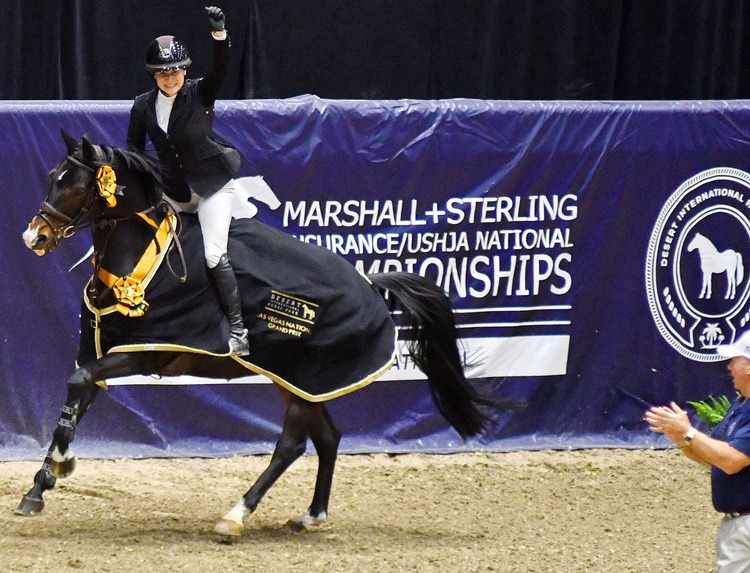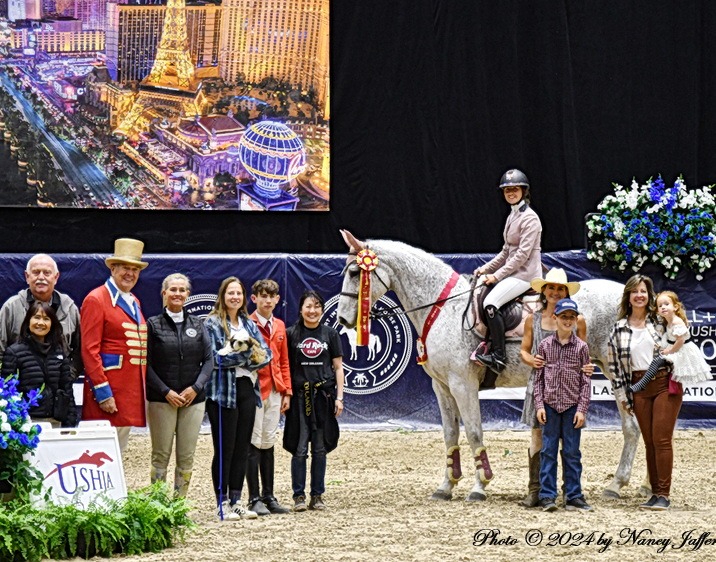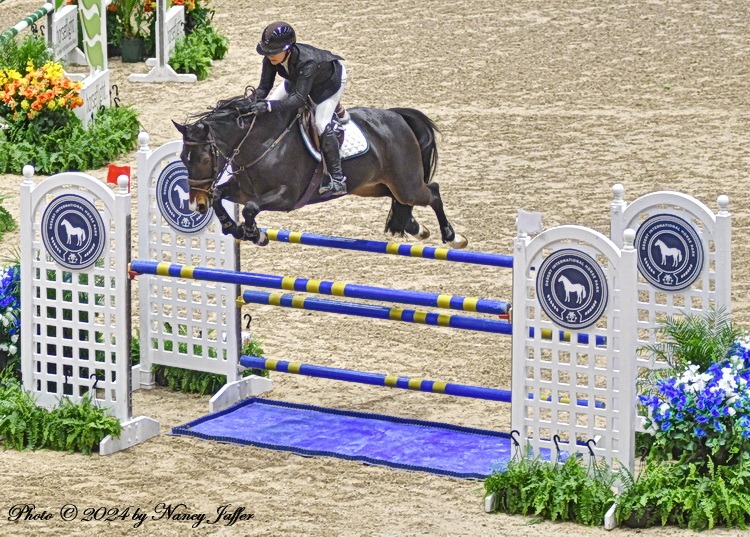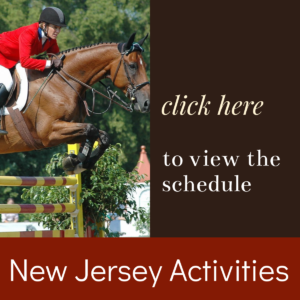It’s the West coast’s version of “indoors,” the time-honored circuit that runs from the end of September through the beginning of November in the East.
The Las Vegas National, hosting the Marshall+Sterling Insurance/U.S. Hunter Jumper Association National Championships, is a standout standalone for a region where the most important shows are outdoors.
The venue is a casino hotel, the South Point. It’s 570,000-square-foot equestrian complex under one roof has 1,147 indoor stalls and hosts 46 weeks of equestrian sport annually.
Seeing riders in boots and breeches walking past the wildly dinging slot machines is a bit incongruous, but it’s fun, and they love it. The show, which ended its seven-day run on Sunday, plays along with the Vegas spirit, offering special awards for bling turnout to juniors and amateurs. They showed up in everything from a red-sequined jacket to a shiny pink jumpsuit.
Vegas first became a prime destination for show jumpers in 2000, when it hosted a ground-breaking show biz version of the FEI World Cup Finals, complete with fireworks, an Elvis impersonator and an abundance of glitter. It held the finals four more times at University of Nevada at Las Vegas’ Thomas & Mack Center, with the 2020 edition cancelled due to Covid.
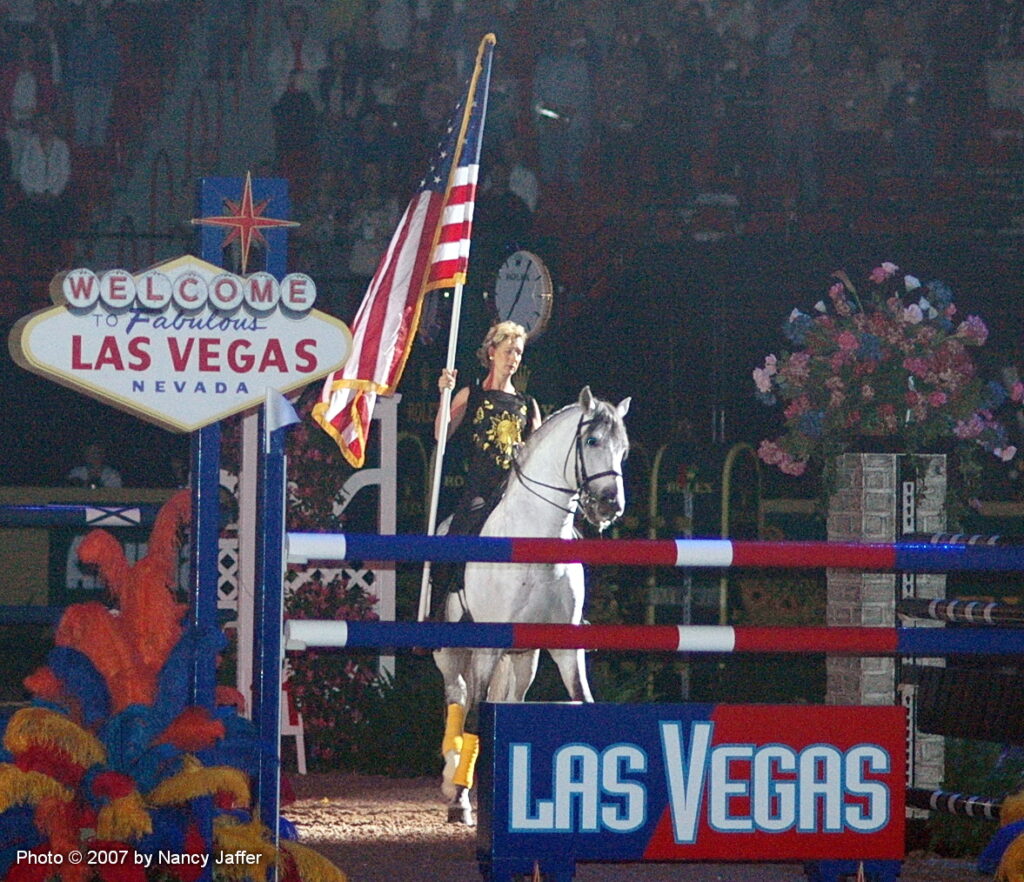
The World Cup Finals at Thomas & Mack put Vegas on the map for show jumping. (Photo © 2024 by Nancy Jaffer)
In the early 2000s, I attended a discussion at South Point about the possibility of having the casino hotel present one leg of the East coast National Horse Show after it left Madison Square Garden, but the idea came to nothing.
Decades later, the USHJA Championships demonstrate all that concept could have been, with classes running simultaneously in three rings and offerings ranging from jumpers over 2-foot, 3-inch fences to a $49,999 1.40 meter grand prix, national hunter derbies, leadline, all flavors of equitation and many more.
Show manager Pat Boyle remarked “The whole concept of this event with the USHJA is allowing the people who have never been to a really big horse show and finals before” to participate.
“It’s kind of a two-part horse show. You have this group that has never experienced this high level, all these affiliate kids who qualified in their hometowns locally at small shows and come to a big national championship, which is amazing.
“But it also caters to the high-end people. Everyone has an opportunity. You walk around, you feel the vibe, you feel the excitement. They come with grandmas, grandpas, aunts, uncles. To see the excitement at all different levels; it’s what makes you get up every morning.”
Yet this year’s show easily could.have been no show. The FEI component, which included a World Cup qualifier, was cancelled at nearly the last minute. But California’s Desert International Horse Park CEO, Steve Hankin, became involved to make sure the competition that is a goal for so many would go on, even without FEI classes. That was important.
“Kudos to Steve Hankin and all the partners at Desert Horse Park for jumping in when this thing maybe wasn’t going to happen at all,” said Pat.
“We said, `No, we can’t let that happen.’”
After a one-hour meeting with Steve, Bill Moroney of the U.S. Equestrian Federation and USHJA President Britt McCormick, “We pulled together and said, `We’re going to make it happen,’” Pat recalled, acknowledging organizers were conscious that exhibitors already had made their plans and reservations, while “kids have been dreaming about this for 10 months.”
Exhibitor Paige Walkenbach agreed about the youth perspective, explaining, “It’s a fun thing to look forward to at the end of the year. It’s cool being in Las Vegas for a horse show. It’s so random, but so fun.””

Paige Walkenbach and Princeton, winner of the national junior amateur hunter derby. (Photo © 2024 by Nancy Jaffer)
The Arizona rider won the junior/adult hunter derby on Princeton and also claimed the California Professional Horsesman’s Association West Coast Equestrian Junior/Amateur medal final, a jumper-style equitation class. She comes back every year for it, having finished third, second and now, finally, landed on the top tier with Bigtalu GZ, a horse she began showing only the previous weekend.
Paige was also a star on the Eastern indoor circuit this year, taking the National Horse Show’s Grand Hunter Championship in Kentucky, and many other prizes along the way.
Being a winner East and West — which is more important for the rider who is heading to Florida for the beginning of her final year as a junior?
“Coming back here is kind of like a home to me,” Paige observed while wearing the colorful WCE medal around her neck after the three-round class.
“I live on the West coast, so it’s always nice seeing familiar faces, people I’ve grown up with. East is like a whole other world, new people. It’s just so special going to both coasts.”
Kasey Ament, a California professional, was victorious in the grand prix with her long-time mount, Gaia, “the fastest, the bravest, the most game.” She follows course designer Anderson Lima when he’s on the West coast because she thinks her horses jump better after tackling the routes he sets.
“I really enjoy this show,” the winner added, saying it felt more relaxed without the FEI classes.
“I come to Las Vegas every year,” said Kasey, who has ridden in the FEI grands prix at the show previously. She was the 2004 winner of the BET/USEF Show Jumping Talent Search Finals West, as it was called at the time.
The success of the DIHP-produced fixture is even more impressive because organizers had a very short time to put it together without the FEI element.
“It is a very important horse show for a very important segment of customers,” said Steve Hankin.
“Even though we’ve only been at it for 60 days, we were hoping to make it special and I think the reaction has been great. There are not a lot of opportunities on the West coast to ride indoors. It’s a different horse show than it’s been. I feel really good about it.”
The big question is what will happen next year, and will there be an FEI component again? Without FEI, more riders had a chance to compete and ride in the main ring, the South Point Arena.
“I think everybody is trying to figure out a good path forward that maintains this special horse show,” Steve said.

Even leadliners, like Jamison Mahoney, have a chance to shine at the Las Vegas National. (Photo © 2024 by Nancy Jaffer)
“We’re pretty invested to continue to make it successful. It’s not, in the end, our decision,” he continued, saying that USEF and USHJA are also part of the equation, but he is “hopeful about it. We have a voice at the table.”
At a post-show meeting of the principals, he expects the conversation to answer these questions, “What did we learn and where do we go? I have more of a bias to try and figure out how to make it work than I did going into it. It’s a very important show to try to figure out and make it sustainable. We’re pretty happy with it.”
“I think there’s a lot of passion for it and a lot of desire to make it work,” he emphasized, adding that the South Point crew was “super to work with. What great partners they are. Everything we’ve needed, they’re been there for us.”
The USHJA’s Britt McCormick, making his first trip to the show, admitted, “I went into it a long-term skeptic. I’d never been, so I had nothing to base that on.”
However, he soon changed his mind.
“After being there and seeing the production Desert and Pat put on and watching the affiliate side, our side, I’m blown away by it.
“I’m a huge fan. I think it has the potential to be one of the top championships in the country. It was above and beyond anything I could have ever imagined. I see even more growth potential.”

